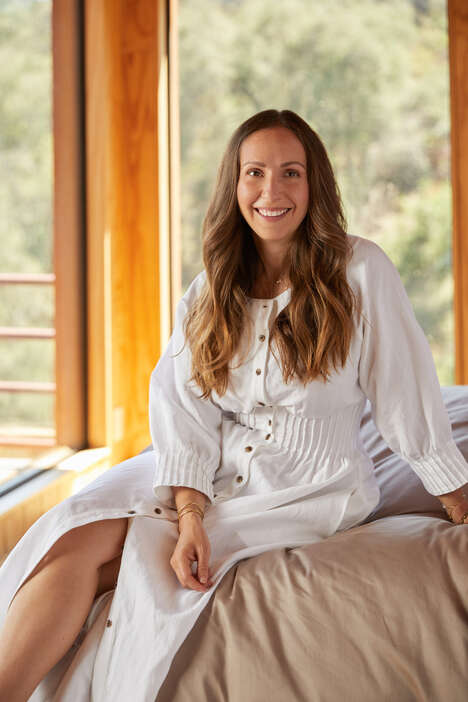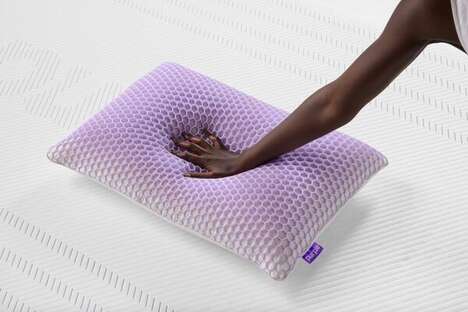Choosing Sustainable Materials
An Interview with Parachute Founder and CEO Ariel Kaye
 With past experience in fashion and advertising, Ariel Kaye transformed her passion for interior design into a multimillion dollar business. The CEO of Parachute has built the brand into a household name for high quality bedding and lifestyle goods, with dedication to premium craftsmanship and sustainability at its core.
With past experience in fashion and advertising, Ariel Kaye transformed her passion for interior design into a multimillion dollar business. The CEO of Parachute has built the brand into a household name for high quality bedding and lifestyle goods, with dedication to premium craftsmanship and sustainability at its core. 1. Tell us about yourself and how did the idea for Parachute first come about?
My background prior to starting Parachute was a little unconventional. I enjoyed wearing a lot of different career hats and was constantly looking for something that I could really have an impact on. I bounced around from a number of jobs after I graduated from college like pr and fashion and ended up going to grad school. During that time, I was studying media and consumer behavior and ended up working in advertising for many years, focusing on strategic thinking. This experience taught me to understand the consumer, how to connect with them, how to motivate and inspire them, and how to build relationships from brand to consumer.
While I loved that, I was always obsessed with home and design, leading me to start an interior design blog that featured products I loved, along with DIY and design projects that I worked on with friends in New York. And so I found this love for this category and really became a super consumer in the space. In 2012, I hit a point in my career where I really wanted to do something bigger and something more entrepreneurial. I wanted to merge my interests in design and home with my interest in building brands, and this was around the time that direct-to-consumer businesses were really just getting started. I was really connecting with that shopping behavior and feeling very inspired by the way that this new value proposition was presenting itself with DTC brands.
I originally thought I’d join a startup or an early stage company where I could learn a lot and take on a bigger role later. I then had an aha moment like many founders do where I realized that there's such an opportunity to do something more interesting and to really create quality products in the home space, as there was really nothing going on like us that was digitally native.
I decided to take a leap of faith and quit my job and this idea to launch Parachute came to be because there was no similar brand in this space at all. It was really about people telling you what store they went to shop for these products, but no one could really tell you what brand they were purchasing. I thought that was such an interesting opportunity. Like how could these products that you use every single day – a 30 billion category 10 years ago – be completely brandless, and so I decided to start a brand.
2. How do you and your team generate new ideas? Are there any specific rituals that you rely on to reset creativity?
We really seek inspiration everywhere. Personally, I look for inspiration in nature and in the outdoors. I'm always really hyper aware of my surroundings and of the textures, colors and patterns of things that I find to be very interesting and eye-catching. At Parachute, we're a very collaborative team so a lot of our brainstorming around new products, creative ideas or around conceptualizing a strategy for a season happens collectively.
We have whiteboard sessions, we brainstorm, we get out of our own way in order to think outside the box and be more creative. For me, being outside is really inspiring and helps me get out of a creative funk. I like to move my body, exercise, go on a walk just to get fresh air, or sit in the sun or on the beach. I think that kind of expansiveness helps reset any kind of stagnant energy and sleep is also very important.
As a brand, we really try to encourage people to take care of themselves, and so much of what we talk about as a brand is how to get a great night’s sleep and how to create a more comfortable home. We really believe that you should be living that, and not just talking about it.
3. How do you identify trends and what role do trends play in your creative process?
We definitely look at trends that are happening across home, design and fashion spaces. We conduct surveys constantly with customers and non-customers internally amongst our team and look at every opportunity to connect with people, whether it's in store, online, across social channels, or through customer experience focus groups. So we're constantly soliciting feedback and trying to learn what our customer wants to see more of.
We also attend conferences and events that are really specific to the home space and that's where all of the manufacturers are. These events are great at identifying potential trends and showing us new fabrications and things that might be interesting for our business.
While trends are important, we also try to take everything with a grain of salt. Even as we're looking out at what’s happening around us, we want to make sure we’re staying connected to who we are as a brand and forging our own paths. I would say that we probably fall in the middle where we actually really enjoy that information and find it valuable in growing with our consumer and understanding them. At the same time, we are trying to build a brand that has a very unique aesthetic, and sometimes that requires us to focus on what we intuitively think or what our team feels like based on their expertise. A lot of our product assortment is also based on our core collections that are not trend-focused. They don't go out of style and they’re kind of the basics that people know and love. So we've got this core business and then we look at how trends can impact our seasonal launches.
4. What is the biggest challenge you face while innovating?
There have been millions of challenges along the way, especially in the very early days. In the beginning, I was doing everything in order to learn. I'd never worked in retail, I’d never built a digital brand before, so much of my experience in the early years was about really leveraging a network of people to help guide me and answer my questions. And, um, and you know, that was very helpful. A lot of it was trial and error, and shooting from the hip and hoping things worked.
Specifically, we had challenges with inventory in the early days, with not having enough and selling through inventory and being back ordered for many months and with just managing customer expectations. Fundraising has also always been challenging for us – we've raised capital from different investors and that's never an easy process.
I generally try to look at challenges as opportunities where you typically grow and evolve to become a better brand. So I have a real optimistic lens around how to navigate through challenges and looking at that as an opportunity to grow and evolve as an individual, as a leader, and as a brand.
5. Has there ever been an instance where another industry has inspired innovation at Parachute?
For sure and we look for inspiration everywhere. I'm really inspired by art and like to go to museums and galleries to see how different artists and mediums look at color. I’m also really inspired by food and just the sensory experience associated with dining – whether that’s fine dining or non fine dining. I also look at fashion and the innovation that's happening within that space. That's kind of more directly related, considering that they're both fabric-based industries. I probably look more outside of the category for inspiration than within the category.
6. What makes an innovative work culture? How do you create a culture of innovation?
At Parachute, we are constantly looking to grow and improve internally as a community, as a culture, and as a brand. We're always looking for feedback from our team, and not just collecting that feedback, but rather putting action plans towards what it means as a brand and as leaders in order to continue to evolve our culture, who we are and how we work.
I think we've all been pushed over the past few years because of remote and hybrid working and having to get things done in a different way than we had ever done before, so we're being extra mindful of what that means.
Being innovative requires taking risks and having a culture that encourages and supports outside-of-the-box thinking, learning, growing, being adaptable and being open to change is crucial. I think especially in the past few years, there's been so much uncertainty and changes in consumer behavior and we've gone through quite a cycle of a new world. And so being able to adapt, whether it's internally or in the way that we engage with customers externally is definitely always top of mind and really important for us.
7. Looking to the future, how will Parachute continue to be a leader in innovation? Can you share any exciting projects that the brand has in the works?
I think sustainability really comes to mind when I think about how we're going to continue to lead through innovation. It’s one of our biggest focuses and initiatives. We’re really focused on providing the customer with clean and sustainable products that are both good for our customers and the planet. We recently launched a furniture collection and decided not to use any performance fabrics because they have pfas on them, and that's probably the most common fabric you see across the industry. Performance fabrics and pfas are forever chemicals. They don't go away, and there's a lot of research that's coming out about the negative impacts of these chemicals. There's certainly plenty of positive things as far as cleaning and durability with performance fabrics, but we decided to not offer them as a brand, despite their popularity. We instead chose to look at alternative fabrics that are durable and can still be cleaned and ideal for consumers with kids or pets or who want to use these products in high traffic areas.
That’s something I'm really proud of, and we want to be innovators as far as sustainability goes in the home space, as it’s a category that really needs a ton of improvement.
References: parachutehome


